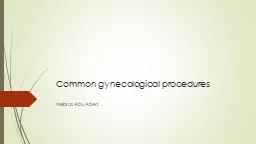

Nebras Abu Abed Hysteroscopy Hysteroscopy is the inspection of the uterine cavity by endoscopy with access through the cervix It allows for the diagnosis of intrauterine pathology and serves as a method for surgical intervention operative hysteroscopy ID: 934413
Download Presentation The PPT/PDF document "Common gynecological procedures" is the property of its rightful owner. Permission is granted to download and print the materials on this web site for personal, non-commercial use only, and to display it on your personal computer provided you do not modify the materials and that you retain all copyright notices contained in the materials. By downloading content from our website, you accept the terms of this agreement.
Slide1
Common gynecological procedures
Nebras Abu Abed
Slide2Hysteroscopy
Hysteroscopy
is the inspection of the
uterine cavity
by
endoscopy
with access through the
cervix
. It allows for the diagnosis of intrauterine pathology and serves as a method for surgical intervention (operative hysteroscopy
).
A
hysteroscope
is an endoscope that carries
optical and light channels
or fibers. It is introduced in a sheath that provides an inflow and outflow channel for insufflation of the uterine cavity. In addition, an
operative channel
may be present to introduce scissors, graspers or biopsy
instruments
Slide3Slide4Slide5Slide6Two main types : rigid and flexible
The flexible
hysteroscope
is most commonly used for
office hysteroscopy
. It is notable for its flexibility, with a tip that deflects over a range of 120-160°. Its most appropriate use is to accommodate the
irregularly shaped uterus and to navigate around intrauterine lesions
. It is also used for diagnostic and operative procedures.
During insertion,
the flexible contour accommodates to the cervix more easily
than does a rigid scope of a similarly small diameter.
Slide7Media
The use of media is critical for panoramic inspection of the uterine cavity. The medium opens the potential space of the otherwise narrow uterine cavity
.
Insufflation by using either
gas
(CO2) or
fluid
(NS
).
Carbon dioxide (CO
2
) is rapidly absorbed and easily cleared from the body by
respiration.
The gas easily flows through narrow channels in small-diameter scopes, making it useful for office-based diagnostic hysteroscopy.
However, this method offers no way to clear blood from the
scope
.
The advantage of fluid over gas is the
symmetric distention of the uterus with fluid
and
its effective ability to flush
blood, mucus, bubbles, and small tissue fragments out of the visual field.
Slide8With a patient in
the lithotomy position
, the cervix is visualized by placing a
speculum
in the vagina. The distal end of
the telescope is passed into a dilated cervical canal
, and, under direct visualization, the instrument is advanced into the uterine cavity. A camera is commonly attached to the proximal end of the
hysteroscope
to broadcast the image onto a large video screen.
Slide9Indications
Any abnormal bleeding from the uterus can be investigated by hysteroscopy, including
:
• Postmenopausal bleeding
.
• Irregular menstruation, intermenstrual bleeding and
postcoital
bleeding.
•
Persistent heavy menstrual bleeding
Persistent discharge
.
•
Suspected uterine malformations
.
• Suspected
Asherman’s
syndrome.
•
Essure
hysteroscopic
sterilization(
Essure
contraceptive
tubal
occlusion
device
)
•
endometrial
biopsy
An operating
hysteroscope
can also be used to resect endometrial pathology such
as fibroids and
polyp
s
and
uterine
septums
Slide10Serious
side effects may include
persistent pain
,
perforation of the uterus and fallopian tubes
, and
migration of the coils into the pelvis or abdomen
Slide11Complications
•
Perforation of the uterus
.
• Cervical damage – if cervical dilatation is necessary.
•
If there is infection present, hysteroscopy can cause ascending infection
.
•
Bleeding
https://www.youtube.com/watch?v=MzixPFAsnAU
Slide12laparoscopy
Laparoscopy allows visualization of the peritoneal cavity. This involves insertion of a needle called a
Veress
needle into a suitable puncture point in the umbilicus. This allows insufflation of the peritoneal cavity with carbon dioxide so that a larger instrument can be inserted.
Slide13Slide14Indications
•
Suspected ectopic pregnancy.
•
Ovarian cyst accident and acute pelvic pain.
•
Undiagnosed pelvic pain.
•
Tubal patency testing.
•
Sterilization.
•
endometriosis
•
ovarian cystectomy or oophorectomy
Slide15Complications
Complications
are
uncommon
, but include
damage to any of the intra-abdominal structures
, such as bowel and major blood vessels. The bladder is always emptied prior to the procedure to avoid bladder injury
. Incisional hernia has been reported
Slide16MYOMECTOMY
fertility
sparing surgical technique for resection of fibroids
.
Abdominal MYOMECTOMY .
Vaginal
myomectomy.
Endoscopic
myomectomy: -
hysteroscopic
-
laparoscop
Slide17indications
Abdominal pain/pressure symptoms
.
Suspicion of malignancy.
Infertility
and/or recurrent pregnancy loss.
Abnormal
bleeding
Slide18complications
Intraoperative bleeding from vascular fibroids.
Risk
of unplanned hysterectomy.
Postoperative
intra-abdominal adhesions.
Slide19hysterosaplingography
Is a Diagnostic Outpatient radiologic imaging procedure performed without anesthesia
..
A cannula is placed in
the
endocervical
canal
and radio opaque fluid is injected allowing assessment of uterine malformation
malformation
(uterine septum ) and
Asherman's
syndrome
.
Tubal pathology
can also be assessed by observing internal tubal anatomy and seeing whether the dye spills in to pelvis cavity
Slide20